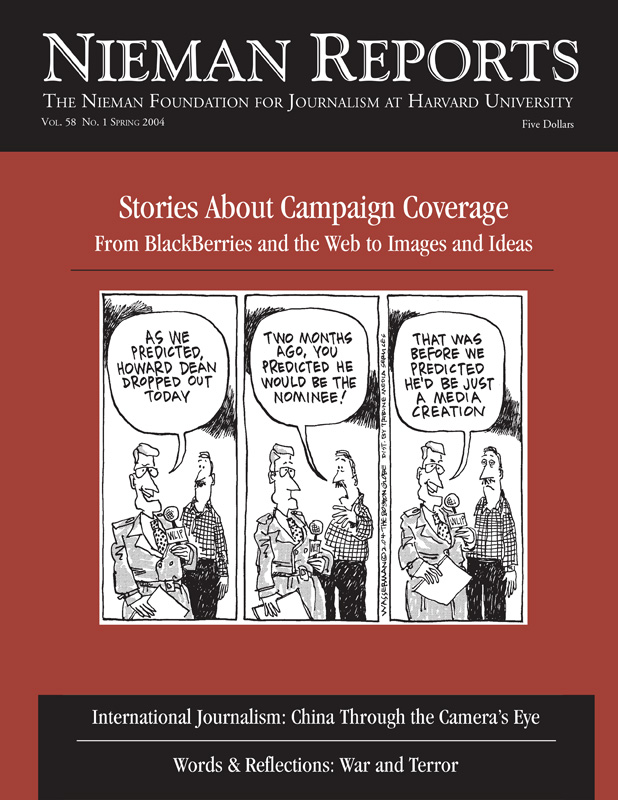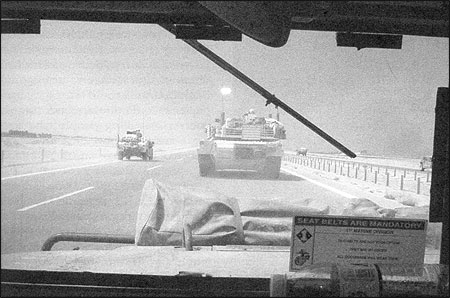
Tanks and other armored vehicles move down a highway in Kuwait, on their way to the Iraqi border, a day before the start of the war. Photo taken from the backseat of Lt. Col. Bryan P. McCoy’s Humvee. Photo by John Koopman/San Francisco Chronicle.
I never set out to write a serial narrative about the war in Iraq. I never planned for it, and I never considered writing anything more than daily stories from the battlefield. But something happened when I got back from Baghdad. I started writing about the war, putting it all together and adding my own experiences. And I just couldn’t stop. I wrote and wrote and wrote and when it was all done, I had 27,000 words spread out over six days, covering about 700 column inches.
The project began in the fall of 2002, when the San Francisco Chronicle’s foreign and national editor, Andrew S. Ross, asked me if I’d be interested in covering the war in Iraq, which appeared imminent. Ross wanted me because I’d spent four years of precious youth in the Marines, and I had a fair amount of experience as a reporter.
So I was to be an embedded reporter. I was lucky that I got the nod early enough and knew about how the military works. It allowed me to spend some time scouting the 1st Marine Division and finding a good, solid infantry battalion. I met these guys, the Third Battalion, Fourth Marine Regiment, at Twentynine Palms, California, conducting desert training. I told the division public affairs office that, if war came, I wanted to go with Three-Four.
This was useful because it meant I could spend the entire war, and preparation for war, with one unit. Later, I saw a lot of embedded reporters hopping from unit to unit, trying to get to where the action was. But they never had much time to get to know anyone, and I think the reporting was not as in-depth as it could have been.
In San Francisco, I met with my editors to plan for war coverage. We had a new managing editor, Robert Rosenthal, former executive editor for The Philadelphia Inquirer and a former foreign correspondent. Rosenthal had some good ideas, but we didn’t get too detailed in the planning. We figured that all our plans would likely go out the window once the war started. My thinking was, “Go check things out, and look for good stories.”
I’m a metro reporter. I like a good feature story, but the ones I normally do go on for 35 or 40 inches. A really big story is 50 inches. Usually I write daily stories and the occasional Sunday story. As far as I was concerned, I would cover the war in Iraq the same way. Someone would, no doubt, write a great narrative or magazine-style piece. But it wasn’t going to be me. Just give me a daily deadline, and I’m happy.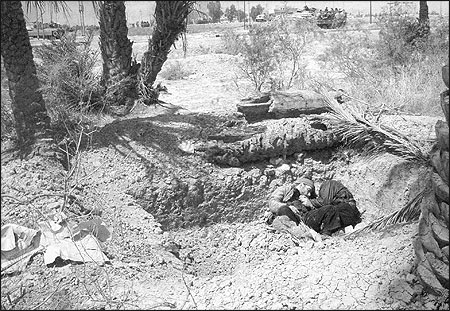
Two dead Iraqis lie huddled in a fighting hole outside Kut, Iraq. The Iraqis had ambushed a column of Marine tanks and infantry, resulting in a firefight that killed one Marine and a dozen or more Iraqis. Photo by John Koopman/San Francisco Chronicle.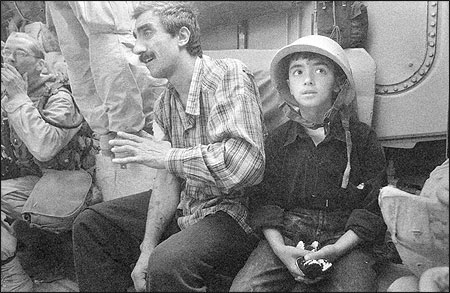
A man and his son ride in the back of a Marine amphibious assault vehicle. The father was shot in the arm after he approached a building that was being looted. Photo by John Koopman/San Francisco Chronicle.
Reporting From the War
And that’s the way I worked it, first in Kuwait as the troops prepared for war and later, after they crossed the border and attacked Iraq. I wrote features, mostly, in Kuwait and daily dispatches from the front in Iraq. It was immediate and timely.
But something happened about a week after the war started. I found my voice. It was after the battle for Diwaniyah. It was a brutal fight, and I saw a lot of dead Iraqis. The Marines pounded them. The battle was over about two hours before sunset, so I had a chance to set my folding stool in the dirt and compose something a little more eloquent than the spot reports I’d done previously.
A couple of days later, I was there when the driver of the Humvee I rode in was killed in an ambush. A few days after that, the Marines were fighting for control of a bridge outside Baghdad when an Iraqi artillery shell hit a Marine armored vehicle. The blast killed two Marines and struck so close I got sprayed with hot engine oil. And a few days later, these Marines helped pull down the statue of Saddam Hussein.
Despite all this, I never wanted to write in the first person. I didn’t feel worthy. I wasn’t out there killing and dying. As tough as it was on me, I wasn’t walking guard post or spending the night writing up battle plans. The story belonged to the Marines and later to the Iraqis themselves.
In Baghdad, I got an e-mail from Rosenthal. He said I should conduct interviews and gather background so I could return to San Francisco and do a larger story, “putting it all together.” That sounded fine to me, but I was still thinking 80 or 100-inch story, just stringing everything along in chronological order.
And then I met an editor who would destroy all my notions: Carolyn White, a former book editor and features editor at the Inquirer and Rolling Stone. She’d been hired as assistant managing editor for features while I was away. Rosenthal introduced me to her when I got back. He told us to get together and write something about the war that would be similar to what he saw Mark Bowden do for the Inquirer when he wrote a narrative series called “Blackhawk Down.”
Hey, no pressure there.
Carolyn and I got together to talk about the project. She was a book editor and so used books as tools for structure. She brought out some of the better war literature, including “Dispatches” and “Jarhead.” Don’t read them, she said. “I’ll read them and pass on concepts to you.”
I wasn’t sure where this was all going, but the ride seemed like fun. I sat down and started cranking it out. It grew and grew. To 10,000 words. Then 15,000. I would show Carolyn what I had, and she would simply say: “Great. Give me more.”
Rosenthal, meanwhile, wondered if I should try to tell the story of the war through the eyes of the battalion commander, Lt. Col. Bryan P. McCoy. The idea was sound. I’d spent a lot of time with McCoy and knew him well. But I hadn’t spent all my time following him, and now that the Marines were back in the United States, my access to McCoy was much more limited.
I knew that the best story I had was the one I’d seen first-hand. Now I wanted to write a first-person narrative, because I felt it was the only way I could really make the war personal. To bring out detailed, descriptive pieces of Iraq, the Marines, the sand and the heat, I believed I had to tell the story through my voice. Though this realization helped me overcome my earlier insistence that I would not write about this in the first person, what I didn’t want to do was to make myself the center of attention. The idea was to show how others fought, acted and interacted through the camera lens of my eyes.
Carolyn was with me. But we both knew that I had to pull it off and convince Rosenthal, or the whole package might not fly.
Time passed. Carolyn was busy putting together her department, and I sometimes got called away to write other stories. I started to worry that we had missed the boat. The offensive war was long over. The story in Iraq was now about the occupation and roadside bombs. Carolyn said it wasn’t important. She wanted a literary story, one that told the tale of Marines at war. It wasn’t about news by then, she said. Either we could produce a well-written series that would capture readers’ attention and give a timeless, gripping account of combat, or we’d just spike it and move on.
So I wrote 20,000 words and then 25,000. I told Rosenthal how long it was. He told me to keep going.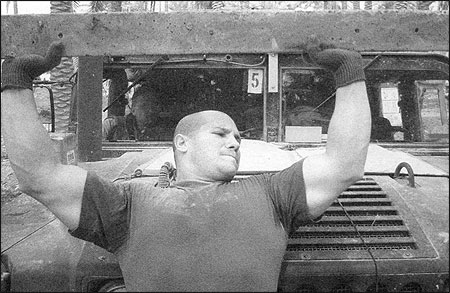
A Marine found a chunk of concrete to lift when he had a few moments after his unit crossed the Dyala Canal Bridge. Photo by John Koopman/San Francisco Chronicle.
Fresh Memories of a Memorable Time
Carolyn took the work home one weekend and immersed herself. The following week, she invited me to lunch on the roof. She brought with her two copies of “Moby Dick.” After we ate, she asked me to read aloud the introduction in “Moby Dick.” I was game, so I did it. That introduction, after “Call me Ishmael,” was all about man’s preoccupation and fascination with the sea. Carolyn just said: “That’s your story. Man’s fascination with war. The war is the whale. Write an introduction that emulates Melville, and structure your chapters the way he does.”
It was like a bell went off. I wrote an introduction that spoke of men and war, and I recast some of my chapters. I wrote new passages that focused on small but important details. Of the Marines, their habits, sights, sounds and smells. I added passages from my own experience. What it’s like to be in the Marines. How much I missed my son. Some of the physical hardships we had to endure.
Some of this came from my notes. I had plenty of material that I’d never used in daily stories. But most of it was the fresh memory of a memorable time. I’d told and retold the stories hundreds of times since returning from Baghdad. And I could retell it again on paper. I would double-check some vignettes by calling people who were there and going over it with them. I only had to change one or two things by using this system.
I turned in 27,000 words and then sat and waited. By this time, I hated the story, couldn’t stand to read a word. It got so that I would think of something I wanted to add and tell Carolyn. She would say, “It’s already in there.” I had no idea what I had, or how I’d gotten there.
In the front office, Rosenthal and Carolyn discussed the story, how it was written, where it would run and when.
Rosenthal was fine with my approach. But he told me he didn’t want to run the story on the front page. It would go in our features section, called Datebook, with a front-page reference.
He said the decision wasn’t meant to diminish the work. He said it was because the story was in first person and literary in nature. I had no problem with that. With as much real estate as they planned to give up, it could have run in the classified section for all I cared.
Carolyn got the story in one long take. I’d written a couple dozen chapters, some just a few paragraphs, others several pages long. She cut it into six sections. It cut rather well. She looked for natural breaks, letting the rise and fall of drama dictate where each day would end. Without consciously trying to do it, I’d written in a rhythm. Events built up to a climax, or a conclusion, sometimes with resolution. And that’s one of the things that made the series work. It was more than just one long story. Every installment brought something new and ended in a rousing fashion. Some more than others. But it kept readers coming back for more.
After it appeared in November, we received more than 600 e-mails and letters. They’re still coming in.
Despite my background as a city desk reporter, I thoroughly enjoyed writing the series. I had the opportunity to use a lot of writing tropes that are usually not associated with journalism, like dialogue and metaphor. It was also cathartic. I had a few demons to exorcise from the war, too. Writing about my experiences helped.
So after it was all done, the paper moved me to the features department. They want more narrative writing. And I’ve got a new beat: the underground sex scene. It looks like we’ll be pushing some boundaries.
John Koopman is a features writer with the San Francisco Chronicle. The narrative series described in this article, “McCoy’s Marines: Darkside Toward Baghdad,” can be found at www.sfgate.com/koopman.
